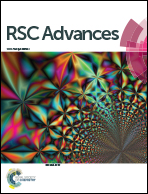Facile synthesis of magnetic resorcinol–formaldehyde (RF) coated carbon nanotubes for methylene blue removal†
Abstract
In this paper, magnetic resorcinol–formaldehyde (RF) resin coated carbon nanotubes were synthesized from hydrophilic magnetic carbon nanotubes (CNTs) with the extended Stober method. Firstly, magnetic CNT composites (CNTs@Fe3O4) were synthesized by the high temperature decomposition process using the iron acetylacetonate as raw materials. Then the resorcinol–formaldehyde polymer can be easily coated on the magnetic CNTs with the extended Stober method. Finally, numerous of gold nanoparticles were assembled on the surface of CNTs@Fe3O4@RF by reducing Au3+ between the RF shell and HAuCl4 solution; meanwhile, the mesoporous carbon coated CNTs@Fe3O4 can also be obtained by calcinations of the CNTs@Fe3O4@RF composites in nitrogen atmosphere. The resulting CNTs@Fe3O4@RF@Au or CNTs@Fe3O4@C composites show not only a magnetic response to an externally applied magnetic field, but also can be a kind of catalyst or adsorbent to catalyze or adsorb the methylene blue (MB), in the ambient temperature.


 Please wait while we load your content...
Please wait while we load your content...